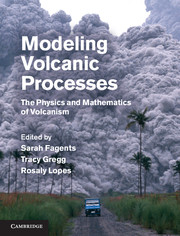Book contents
- Frontmatter
- Contents
- Contributors
- Chapter 1 Introduction
- Chapter 2 Magma chamber dynamics and thermodynamics
- Chapter 3 The dynamics of dike propagation
- Chapter 4 Dynamics of magma ascent in the volcanic conduit
- Chapter 5 Lava flows
- Chapter 6 Unsteady explosive activity
- Chapter 7 Unsteady explosive activity
- Chapter 8 Sustained explosive activity
- Chapter 9 Modeling tephra sedimentation from volcanic plumes
- Chapter 10 Pyroclastic density currents
- Chapter 11 Magma–water interactions
- Chapter 12 Deep-sea eruptions
- Chapter 13 Volcano–ice interactions
- Chapter 14 Modeling lahar behavior and hazards
- Chapter 15 Introduction to quantitative volcano seismology
- Chapter 16 Volcano acoustics
- Chapter 17 Planetary volcanism
- Index
- Plate section
- References
Chapter 1 - Introduction
Published online by Cambridge University Press: 05 March 2013
- Frontmatter
- Contents
- Contributors
- Chapter 1 Introduction
- Chapter 2 Magma chamber dynamics and thermodynamics
- Chapter 3 The dynamics of dike propagation
- Chapter 4 Dynamics of magma ascent in the volcanic conduit
- Chapter 5 Lava flows
- Chapter 6 Unsteady explosive activity
- Chapter 7 Unsteady explosive activity
- Chapter 8 Sustained explosive activity
- Chapter 9 Modeling tephra sedimentation from volcanic plumes
- Chapter 10 Pyroclastic density currents
- Chapter 11 Magma–water interactions
- Chapter 12 Deep-sea eruptions
- Chapter 13 Volcano–ice interactions
- Chapter 14 Modeling lahar behavior and hazards
- Chapter 15 Introduction to quantitative volcano seismology
- Chapter 16 Volcano acoustics
- Chapter 17 Planetary volcanism
- Index
- Plate section
- References
Summary
Scope of this book
The processes involved in volcanic eruptions, from magma generation at depth to eruption and emplacement of deposits at the surface, comprise a suite of interlinked physical phenomena. In seeking to understand volcanic behavior, volcanologists call on a diversity of physics subdisciplines, including fluid dynamics, thermodynamics, solid mechanics, ballistics, and acoustics, to name just a few. Understanding the physical behavior of volcanoes is critical to assessing the hazards posed to the ever-increasing populations living in close proximity to active volcanoes, and thus to mitigating the risks posed by those hazards.
The motivation for producing this book arises in part from the editors’ experiences as educators, as well as our interests in keeping current with developments in volcanologic subdisciplines outside our own. Modeling volcanic processes, and the resulting improvements in our understanding of how volcanoes work, has advanced in leaps and bounds over the past decade or two. This is a result of both a maturation of our field- and laboratory-based understanding of volcanic processes, as well as vast improvements in computational capabilities. Synergies with the similarly rapidly evolving knowledge of geochemical processes also greatly enhance the physical understanding of volcanoes. However, in developing courses for advanced undergraduates and graduate students, we were struck by the lack of an up-to-date single-source book from which we could draw for instructional purposes. While several existing notable books cover the physics of specific aspects of volcanic behavior in detail (e.g., Sparks et al., 1997; Gilbert and Sparks, 1998; Freundt and Rosi, 2001), an advanced, quantitative text covering a wide range of volcanic phenomena is currently lacking in the instructor’s armory. Furthermore, with the rapid developments in the field, the existing books have become outdated. We view this book as the natural next step for students pursuing volcanology beyond introductory level, for which there are several excellent texts (e.g., Cas and Wright, 1988; Francis and Oppenheimer, 2004; Schmincke, 2004; Parfitt and Wilson, 2008), as well as an update on recent developments in the field.
- Type
- Chapter
- Information
- Modeling Volcanic ProcessesThe Physics and Mathematics of Volcanism, pp. 1 - 4Publisher: Cambridge University PressPrint publication year: 2013



